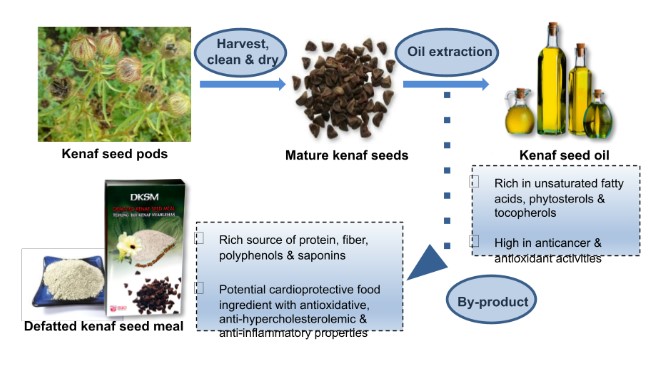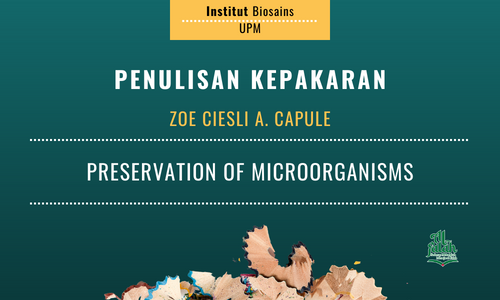Kenaf (Hibiscus cannabinus L.) is an herbaceous, annual/ biennial and short-day cordage crop that grows in the tropical and temperate climates with high rainfall and abundant of sunlight. Fibers derived from the kenaf bast and core are versatile raw materials for various industrial applications, which include paper and pulp, textiles, fabrics, insulation mats, biocomposites, absorption materials, animal bedding, biofuel production and so on. India and China are the major producers of kenaf that contribute to over 70 % of the global production. In 2004, Malaysian government had foreseen the commercial values of kenaf and allocated RM 12 million under the Ninth Malaysia Plan (2006 - 2010) for further research and development of kenaf industry, in order to replace the tobacco plantation. Mature kenaf seeds are grayish brown in colour, glabrous, wedge-shaped and weighed about 35,000 - 40,000 seeds/ kg. Depending on the agroclimatic conditions and variety, kenaf seed yield can reach up to over 1000 kg/ hec. In Malaysia, kenaf (variety V36) plantation of for seed production requires 120 to 150 days to reach maturity with an estimated seed yield up to 400 kg/ hec. In order to achieve the recommended plant populations for optimal kenaf fiber production (185,000-370,000 plants/ hec), only 8 kg/hectare of seed is required for seedling. Hence, kenaf seeds are considered as an agricultural by-product from the kenaf plantation.
Research and innovation in our laboratory (NaturMeds) have been primarily focusing on the potential applications of kenaf seed as functional food ingredient and nutraceutical for the betterment of human health and well-being. From our findings, kenaf seed oil (approximately 20% of the dry seed mass) is mainly consisted of linoleic acid (~ 38%), oleic acid (~ 35%) and palmitic acid (~ 20%), accompanied with the abundance of phytosterols (predominantly β-sitosterol) and tocopherols 1, 2. In addition, kenaf seed oil obtained from supercritical carbon dioxide fluid extraction was found to possess superior antioxidant and anticancer properties via various in vitro and in vivo models 1, 3-6.
Next, our research on kenaf seed was then extended to the defatted kenaf seed meal (DKSM), the secondary by-product (nearly 75% of its seed mass) that is left-over after the oil extraction process. Our studies showed that DKSM was high in protein and crude fiber 7, with the absence of acute oral toxicity. Protein concentrates prepared from DKSM contained almost all essential amino acids (except for tryptophan) and possessed satisfactory functional properties (e.g. water absorption, oil absorption and foaming capacities) as a novel food ingredient 8. On the aspect of health-promoting properties, DKSM and its-derived extracts exhibited appreciably high contents of phenolics and saponins, as well as antioxidant properties 7, 9-11. Supplementation of DKSM and its-derived phenolics-saponins rich extract (PSRE) remarkably improved the blood lipid profile, severity of fatty liver, artherogenic risks and toxicity biomarkers of hypercholesterolemic rats, through multiple cardioprotective mechanisms 12. DKSM and PSRE supplementations also reduced the hypercholesterolemia-associated oxidative stress and systemic inflammation in the rats, by enhancing their endogenous antioxidant defense 13. Findings from our animal study strongly suggest the potential of DKSM and its bioactive rich extract as functional food ingredients with cardioprotective properties.
In conclusion, kenaf seed, as a whole or in its partially purified form, were found to be a safe and nutritive functional food ingredient, with multiple therapeutic properties (i.e. antioxidant, anticancer, anti-inflammatory and cardioprotective properties). In order to further valorise this agricultural by-product, recommendation for future studies will be on the exploration of other nutraceutical properties of kenaf seed, improvement of bioefficacy and biovailability of kenaf bioactives, as well as development of kenaf seed-based functional food prototypes for pre-commercialization initiatives.
References: -
- K. W. Chan and M. Ismail, Supercritical carbon dioxide fluid extraction of Hibiscus cannabinus L. seed oil: a potential solvent-free and high antioxidative edible oil, Food Chemistry, 2009, 114, 970-975.
- A. A. Mariod, B. Matthäus and M. Ismail, Comparison of supercritical fluid and hexane extraction methods in extracting kenaf (Hibiscus cannabinus) seed oil lipids, Journal of the American Oil Chemists' Society, 2011, 88, 931-935.
- S. A. Abd Ghafar, M. Ismail, L. Saiful Yazan, S. Fakurazi, N. Ismail, K. W. Chan and P. Md Tahir, Cytotoxic activity of kenaf seed oils from supercritical carbon dioxide fluid extraction towards human colorectal cancer (HT29) cell lines, Evidence-Based Complementary and Alternative Medicine, 2013, 2013, Article ID 549705.
- J. B. Foo, L. S. Yazan, K. W. Chan, P. M. Tahir and M. Ismail, Kenaf seed oil from supercritical carbon dioxide fluid extraction induced G1 phase cell cycle arrest and apoptosis in leukemia cells, African Journal of Biotechnology, 2011, 10, 5389-5397.
- S. A. A. Ghafar, L. S. Yazan, P. M. Tahir and M. Ismail, Kenaf seed supercritical fluid extract reduces aberrant crypt foci formation in azoxymethane-induced rats, Experimental and Toxicologic Pathology, 2012, 64, 247-251.
- L. S. Yazan, J. B. Foo, S. A. A. Ghafar, K. W. Chan, P. M. Tahir and M. Ismail, Effect of kenaf seed oil from different ways of extraction towards ovarian cancer cells, Food and Bioproducts Processing, 2011, 89, 328-332.
- K. W. Chan, N. M. Khong, S. Iqbal, S. M. Mansor and M. Ismail, Defatted kenaf seed meal (DKSM): Prospective edible flour from agricultural waste with high antioxidant activity, LWT-Food Science and Technology, 2013, 53, 308-313.
- A. A. Mariod, S. F. Fathy and M. Ismail, Preparation and characterisation of protein concentrates from defatted kenaf seed, Food Chemistry, 2010, 123, 747-752.
- K. W. Chan, S. Iqbal, N. M. Khong, D.-J. Ooi and M. Ismail, Antioxidant activity of phenolics–saponins rich fraction prepared from defatted kenaf seed meal, LWT-Food Science and Technology, 2014, 56, 181-186.
- N. M. Yusri, K. W. Chan, S. Iqbal and M. Ismail, Phenolic content and antioxidant activity of Hibiscus cannabinus L. seed extracts after sequential solvent extraction, Molecules, 2012, 17, 12612-12621.
- A. Mariod, R. Ibrahim, M. Ismail and N. Ismail, Antioxidant activity of phenolic extracts from kenaf (Hibiscus cannabinus) seedcake, Grasas y Aceites, 2012, 63, 167-174.
- K. W. Chan, M. Ismail, N. Mohd Esa, M. U. Imam, D. J. Ooi and N. M. Khong, Dietary supplementation of defatted kenaf (Hibiscus cannabinus L.) seed meal and its phenolics–saponins rich extract effectively attenuates diet-induced hypercholesterolemia in rats, Food & Function, 2018, 9, 925-936.
13. K. W. Chan, M. Ismail, N. Mohd Esa, N. B. Mohamed Alitheen, M. U. Imam, D. J. Ooi and N. M. Khong, Defatted Kenaf (Hibiscus cannabinus L.) seed meal and its phenolic-saponin-rich extract protect hypercholesterolemic rats against oxidative stress and systemic inflammation via transcriptional modulation of hepatic antioxidant genes, Oxidative medicine and cellular longevity, 2018, 2018, Article ID 6742571.

Tarikh Input: 03/05/2023 | Kemaskini: 03/05/2023 | azah
PERKONGSIAN MEDIA













.png)






